10 Surprising Superfoods You’ve Never Heard Of To Blend In Your Everyday Life
Discover 10 amazing superfoods you've never heard of that can boost your health and wellbeing. Learn how to easily blend them into your daily life!
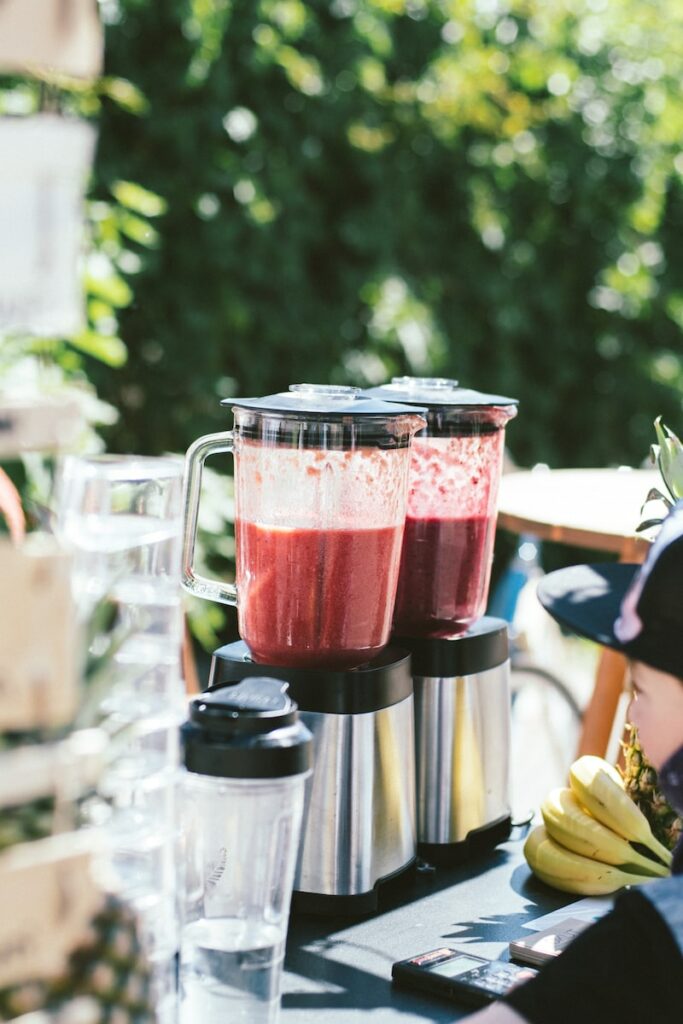
Obesity is a growing epidemic that affects millions of people around the world. Could nutrient-dense superfoods that you may have never heard of before, help you build a better relationship with your body?
According to the World Health Organization, in 2016, more than 1.9 billion adults were overweight, and of those, over 650 million were obese. While there are many factors that contribute to obesity, including genetics and lifestyle, diet plays a significant role. In this article, we will explore 10 surprising superfoods that you may have never heard of, that could make a big difference in your health and weight management. Why not surprise your guests with these simple recipes?
Table of Contents
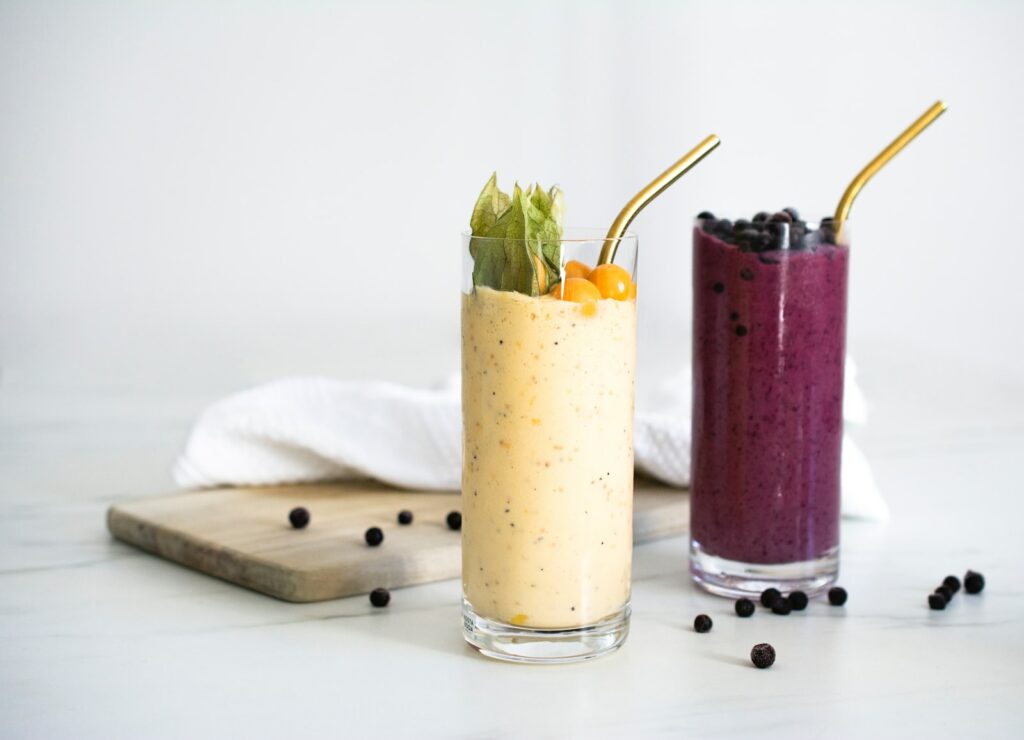
I. Sea Buckthorn
- A tart berry with more vitamin C than an orange
- Contains a variety of essential fatty acids, including omega-3 and omega-7
- Can improve skin health and aid in digestion
Sea buckthorn has a long history of traditional use, with claims that it can slow down the ageing process and offer a range of health benefits. People have used sea buckthorn to treat burns, eczema, acne, indigestion, high blood pressure, and even wrinkled skin. This bright orange berry has gained popularity as a superfood, remains an intriguing and unique addition to the world of superfoods, alongside other foods that balance your diet with potential benefits waiting for you to further explored.
This tart berry may not be on your radar when it comes to superfoods, but it’s worth considering adding to your diet. Sea buckthorn is packed with nutrients that can provide a variety of health benefits.
One of the most impressive aspects of sea buckthorn is its high vitamin C content. In fact, it contains even more vitamin C than an orange. This antioxidant-rich vitamin is essential for immune function, skin health, and collagen production. By incorporating sea buckthorn into your diet, you can help support your body’s defenses and maintain healthy, glowing skin.
But that’s not all sea buckthorn has to offer. It’s also rich in essential fatty acids, including omega-3 and omega-7. These healthy fats can aid in digestion and support cardiovascular health. Additionally, they can help reduce inflammation throughout the body, which can be beneficial for conditions like arthritis and asthma.
If you’re interested in trying sea buckthorn, there are a variety of ways to incorporate it into your diet. You can find sea buckthorn juice, capsules, and even skincare products. However, one delicious way to enjoy sea buckthorn is by adding it to smoothies or using it as a topping for yogurt or oatmeal.
Here’s a simple recipe to try:
Sea Buckthorn Smoothie
- 1 cup unsweetened almond milk
- 1 banana
- 1/2 cup frozen mixed berries
- 1 tbsp sea buckthorn juice
- 1 tbsp honey
Simply blend all ingredients together until smooth, and enjoy!
By adding sea buckthorn to your diet, you can reap the benefits of its high vitamin C content and essential fatty acids. Give it a try and see how it can improve your overall health and wellness.
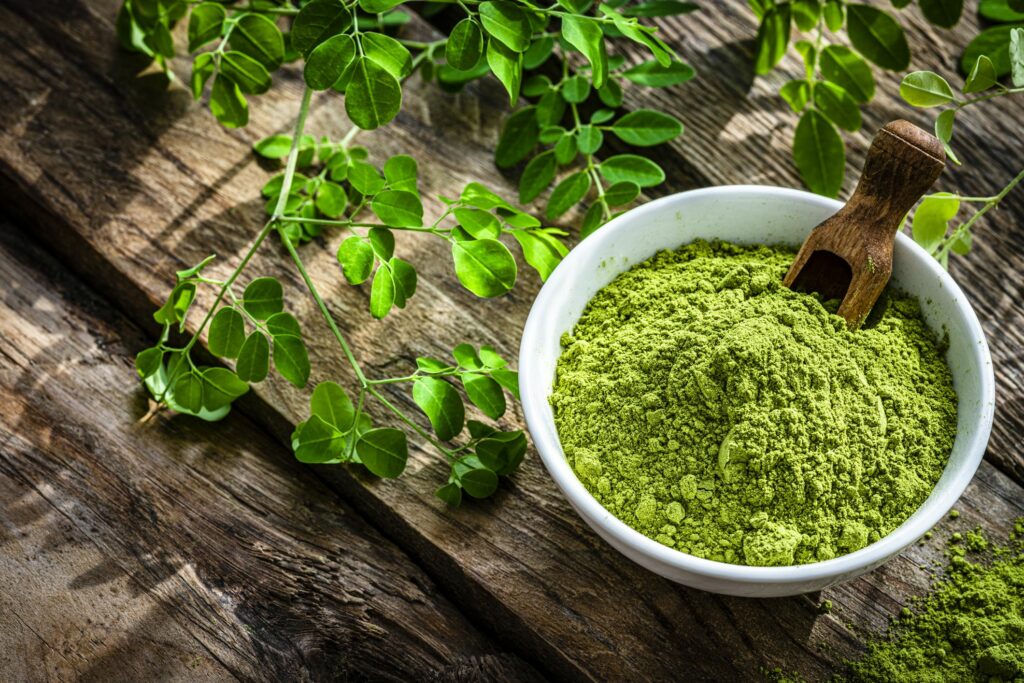
II. Moringa
- A leafy green that is high in antioxidants and anti-inflammatory compounds
- Contains all nine essential amino acids, making it a complete protein source
- Can help reduce inflammation and lower cholesterol levels
Moringa, a plant native to India, has been long used in traditional medicine to protect vital organs like the liver, kidneys, heart, and lungs, and to alleviate pain. Its high antioxidant content plays a significant role in shielding cells from harmful free radicals, which are produced during digestion, smoking, and exposure to radiation. Plant-based antioxidants, such as those found in moringa powder, are highly valued for their therapeutic potential.
However, it is important to note that high doses of moringa supplements may lead to digestive issues such as nausea, diarrhea, and bloating. As with any supplement or medication, it’s essential to consult a healthcare professional before adding moringa to your diet.
This leafy green may not be a household name yet, but it’s quickly gaining popularity in the health and wellness world. And for good reason – moringa is packed with nutrients that can provide a variety of health benefits.
One of the most impressive aspects of moringa is its high antioxidant content. Antioxidants are essential for fighting off harmful free radicals in the body, which can contribute to ageing and disease. In addition to antioxidants, moringa also contains a variety of anti-inflammatory compounds that can help reduce inflammation throughout the body.
But that’s not all – moringa is also a complete protein source, containing all nine essential amino acids. This makes it a great option for vegetarians and vegans who may struggle to get enough protein in their diets. Additionally, moringa has been shown to help lower cholesterol levels, which can be beneficial for heart health.
If you’re interested in trying moringa, there are a variety of ways to incorporate it into your diet. You can find moringa powder, capsules, and even tea. However, one delicious way to enjoy moringa is by adding it to smoothies or using it as a topping for salads.
Here’s a simple recipe to try:
Moringa and Mango Smoothie
- 1 cup unsweetened almond milk
- 1/2 cup frozen mango
- 1 banana
- 1 tbsp moringa powder
- 1 tsp honey
Simply blend all ingredients together until smooth, and enjoy!
By adding moringa to your diet, you can reap the benefits of its high antioxidant and anti-inflammatory content, as well as its complete protein source. Give it a try and see how it can improve your overall health and wellness.
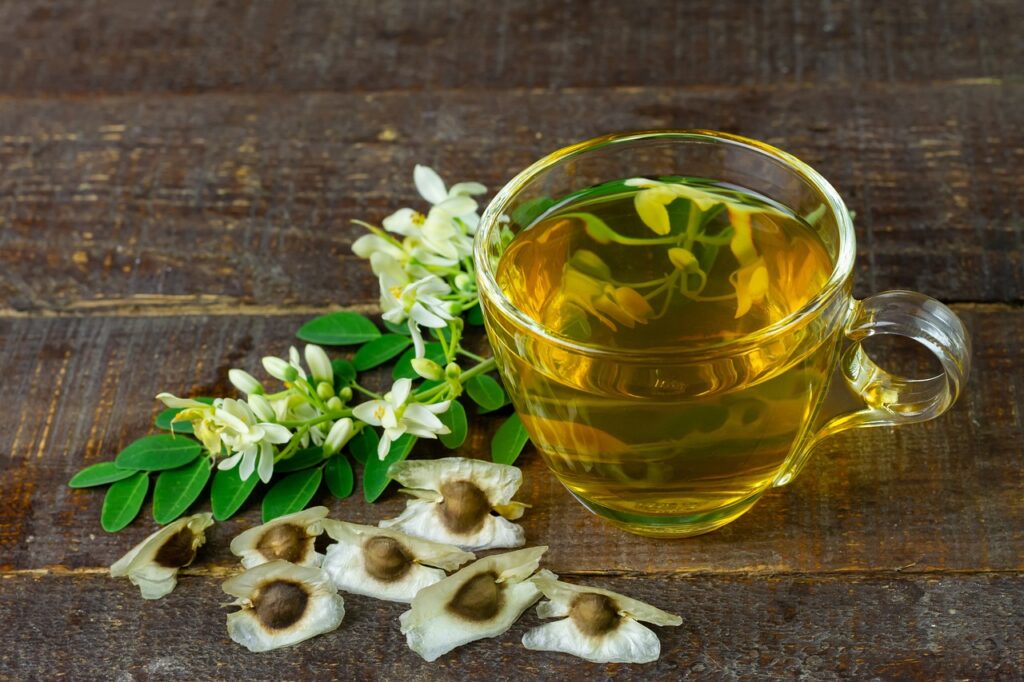
III. Baobab Fruit
- A tangy fruit with more vitamin C than an orange and more potassium than a banana
- High in fiber and antioxidants, which can aid in digestion and fight free radicals
- Can help regulate blood sugar levels and support a healthy immune system
Have you heard of baobab fruit? This tangy fruit may not be a household name, but it’s a nutritional powerhouse that can provide a variety of health benefits. Here are just a few reasons why you should consider adding baobab fruit to your diet:
Firstly, baobab fruit contains more vitamin C than an orange and more potassium than a banana. Vitamin C is essential for immune function and collagen production, while potassium is important for heart health and regulating blood pressure. By incorporating baobab fruit into your diet, you can help support these crucial bodily functions.
But that’s not all – baobab fruit is also high in fibre and antioxidants. Fibre is important for digestion and can help regulate blood sugar levels. Additionally, antioxidants are essential for fighting off harmful free radicals in the body, which can contribute to ageing and disease.
If you’re interested in trying baobab fruit, there are a variety of ways to incorporate it into your diet. You can find baobab powder, capsules, and even energy bars. However, one delicious way to enjoy baobab fruit is by adding it to smoothies or using it as a topping for yogurt or oatmeal.
Here’s a simple recipe to try:
Baobab Smoothie Bowl
- 1 frozen banana
- 1/2 cup frozen mixed berries
- 1 tbsp baobab powder
- 1/2 cup unsweetened almond milk
- Toppings of your choice (e.g. granola, shredded coconut, sliced fruit)
Blend the banana, mixed berries, baobab powder, and almond milk together until smooth. Pour the mixture into a bowl and add your favorite toppings.
By adding baobab fruit to your diet, you can reap the benefits of its high vitamin C and potassium content, as well as its fiber and antioxidants. Give it a try and see how it can improve your overall health and wellness.
IV. Kelp
- A type of seaweed that is high in iodine, which is essential for thyroid health
- Contains antioxidants and anti-inflammatory compounds
- Can help improve brain function and support bone health
Have you ever tried kelp? This type of seaweed is often overlooked, but it’s packed with important nutrients that can benefit your health in a variety of ways. Here are just a few reasons why you should consider adding kelp to your diet:
Firstly, kelp is an excellent source of iodine, which is essential for thyroid health. Your thyroid gland uses iodine to produce hormones that regulate metabolism, and a lack of iodine can lead to thyroid disorders. By incorporating kelp into your diet, you can help ensure that you’re getting enough iodine to support your thyroid function.
But that’s not all – kelp also contains antioxidants and anti-inflammatory compounds. Antioxidants help protect your cells from damage caused by harmful free radicals, while anti-inflammatory compounds can help reduce inflammation in the body. By consuming kelp, you can help support your overall health and reduce the risk of chronic diseases.
In addition, kelp has been shown to have potential benefits for brain function and bone health. Studies have suggested that certain compounds found in kelp may help improve cognitive function and memory, while also promoting bone strength and density.
If you’re interested in trying kelp, there are a variety of ways to incorporate it into your diet. You can find dried kelp, kelp flakes, and even kelp noodles at many health food stores. However, one easy and delicious way to enjoy kelp is by making a simple kelp salad.
Looking for a healthy and easy-to-make salad that won’t add extra calories to your diet? Look no further than kelp salad, a delicious cold mix that is popular in many Chinese households. Kelp, also known as sea belts or Hai Dai in Chinese, is a type of seaweed that is known for its numerous health benefits, including being calorie-free and high in iodine.
Kelp salad is an important part of the Chinese cold mix cuisine and is often served at the beginning of meals or as a complement to wine. This refreshing salad is not only perfect for hot summer days but also during cold winters when served alongside hot soups.
To make this yummy and healthy kelp salad, all you need is 10 minutes and a few simple ingredients. However, it’s worth noting that consuming large amounts of kelp can lead to excessive iodine intake, which can cause thyroid problems in some people. As with any food, moderation is key.
Here’s a recipe to try:
Kelp Salad
- 1/4 cup dried kelp
- 1/4 cup chopped cucumber
- 1/4 cup chopped red onion
- 1 tbsp rice vinegar
- 1 tbsp soy sauce
- 1 tsp sesame oil
- 1 tsp honey
Soak the dried kelp in water for about 10 minutes, or until softened. Drain the water and mix the kelp with the cucumber and red onion. In a separate bowl, whisk together the rice vinegar, soy sauce, sesame oil, and honey. Pour the dressing over the kelp mixture and toss to combine.

V. Amaranth
- A gluten-free grain that is high in protein, fiber, and essential amino acids
- Contains a variety of vitamins and minerals, including iron, magnesium, and phosphorus
- Can help regulate blood sugar levels and aid in digestion
Are you looking for a gluten-free grain that’s packed with nutrition? Look no further than amaranth! This ancient grain has been around for thousands of years, but it’s only recently gained popularity as a health food.
One of the key benefits of amaranth is its high protein content. In fact, it’s one of the few plant-based sources of complete protein, meaning it contains all of the essential amino acids your body needs to function properly. This makes it a great choice for vegetarians and vegans, as well as anyone looking to increase their protein intake.
But that’s not all – amaranth is also high in fiber, which can help promote digestive health and reduce the risk of certain diseases. Additionally, it’s a good source of a variety of vitamins and minerals, including iron, magnesium, and phosphorus.
Research has also suggested that amaranth may have potential benefits for blood sugar regulation. One study found that people who consumed amaranth for breakfast had lower blood sugar levels throughout the day compared to those who ate a wheat-based breakfast. This makes it a great choice for anyone with diabetes or who is trying to manage their blood sugar levels.
So how can you incorporate amaranth into your diet? One easy way is to use it as a substitute for rice or pasta. You can also use it to make porridge, add it to soups and stews, or even use it to make baked goods. Here’s a simple recipe to try:
Amaranth Salad
- 1 cup cooked amaranth
- 1/2 cup cherry tomatoes, halved
- 1/2 cucumber, diced
- 1/4 red onion, thinly sliced
- 2 tbsp chopped fresh parsley
- 1 tbsp olive oil
- 1 tbsp lemon juice
- Salt and pepper to taste
Mix the cooked amaranth, cherry tomatoes, cucumber, red onion, and parsley in a bowl. In a separate bowl, whisk together the olive oil, lemon juice, salt, and pepper. Pour the dressing over the salad and toss to combine.
By adding amaranth to your diet, you can benefit from its high protein and fiber content, as well as a variety of vitamins and minerals. Plus, it’s a versatile ingredient that can be used in a variety of dishes, making it a great addition to any healthy diet.
VI. Camu Camu
- A small berry with the highest vitamin C content of any fruit
- Contains antioxidants and anti-inflammatory compounds
- Can improve immune function and support healthy skin and eyes
If you’re looking for a powerful superfood to boost your immune system and support your overall health, look no further than camu camu. This small berry, which is native to the Amazon rainforest, packs a serious nutritional punch.
Camu camu is a small fruit that packs a powerful punch when it comes to vitamin C. With its purple skin and yellow flesh, this fruit is about the size of a large grape. What makes it truly special is its incredibly high vitamin C content – providing a whopping 2,145 mg per 100 g. In fact, it boasts the highest concentration of vitamin C of any food found on Earth. Vitamin C is a powerful antioxidant that can help protect your cells from damage caused by free radicals, which are unstable molecules that can lead to chronic inflammation and disease.
In addition to vitamin C, camu camu contains other antioxidants and anti-inflammatory compounds that can help support your immune system and reduce your risk of chronic disease. It’s also rich in carotenoids, which are important for healthy skin and eyes.
One of the easiest ways to incorporate camu camu into your diet is by adding it to smoothies or juices. You can also find camu camu supplements in capsule or powder form. Here’s a delicious smoothie recipe that includes camu camu:
Camu Camu Smoothie Recipe:
- 1 cup frozen mixed berries
- 1/2 banana
- 1 tsp camu camu powder
- 1 tbsp chia seeds
- 1 cup almond milk
Combine all ingredients in a blender and blend until smooth. Enjoy as a healthy breakfast or snack!

VII. Celeriac
- A root vegetable that is high in fiber and vitamin K
- Contains antioxidants and anti-inflammatory compounds
- Can improve bone health and aid in digestion
If you’re looking to add more variety to your vegetable repertoire, you might want to consider trying celeriac, also known as celery root. This unique root vegetable is packed with nutrients and has a number of potential health benefits.
One of the standout features of celeriac is its high fiber content. Fiber is essential for maintaining healthy digestion and can help regulate blood sugar levels and lower cholesterol. Celeriac is also a good source of vitamin K, which is important for bone health and blood clotting.
Like many other vegetables, celeriac is rich in antioxidants and anti-inflammatory compounds. These nutrients can help protect your cells from damage and reduce your risk of chronic diseases like heart disease and cancer.
If you’re not sure how to prepare celeriac, you’re in luck. This versatile vegetable can be roasted, mashed, or even sliced thin and fried to make chips. Here’s a simple recipe to get you started:
Roasted Celeriac Recipe:
- 1 large celeriac
- 2 tbsp olive oil
- Salt and pepper to taste
Preheat your oven to 400°F (200°C). Peel the celeriac and chop it into small cubes. Toss the cubes with olive oil, salt, and pepper. Spread the cubes out in a single layer on a baking sheet and roast for 30-40 minutes, or until tender and golden brown. Enjoy as a side dish or add to salads and grain bowls for added flavor and nutrition.
VIII. Jicama
- A crunchy root vegetable that is high in fiber and vitamin C
- Contains antioxidants and anti-inflammatory compounds
- Can improve digestive health and support healthy blood sugar levels
If you’re looking for a delicious and nutritious way to add some crunch to your diet, look no further than jicama. This root vegetable, also known as a Mexican turnip, is low in calories and high in fiber and vitamin C, making it a great choice for anyone looking to improve their overall health.
One of the key benefits of jicama is its high fiber content, which can help improve digestive health and promote feelings of fullness. In addition, jicama is rich in antioxidants and anti-inflammatory compounds, which can help protect against chronic disease and support a healthy immune system.
To enjoy the many benefits of jicama, try adding it to your favorite salads or slaws. You can also slice it up and enjoy it as a crunchy snack with your favorite dip. With its delicious flavor and impressive health benefits, jicama is definitely a superfood worth adding to your diet.
IX. Black Garlic
- A type of garlic that has been fermented, giving it a sweeter and milder flavor
- Contains antioxidants and anti-inflammatory compounds
- Can help lower cholesterol levels and improve heart health
If you’re a garlic lover, you may be surprised to learn about black garlic. This unique ingredient is created by fermenting whole garlic bulbs at high temperatures, resulting in a sweet and mild flavor that is quite different from fresh garlic. But black garlic isn’t just a culinary novelty – it also has some impressive health benefits.
One of the most notable things about black garlic is its antioxidant content. Studies have shown that black garlic has higher levels of antioxidants than fresh garlic, which can help protect your cells from damage caused by free radicals. These compounds also have anti-inflammatory properties, which can help reduce inflammation in the body.
In addition to its antioxidant and anti-inflammatory benefits, black garlic may also be good for your heart. Research has shown that black garlic can help lower cholesterol levels, which can reduce your risk of heart disease. It may also help improve blood pressure and circulation.
So how can you incorporate black garlic into your diet? It’s quite versatile and can be used in a variety of dishes, from roasted meats to pasta sauces. One easy way to enjoy black garlic is to spread it on toast or crackers for a healthy and flavorful snack. You can also add it to dips, marinades, or salad dressings for a unique twist on classic recipes.
If you’re looking for a new ingredient to add to your cooking repertoire, black garlic is definitely worth a try. With its unique flavor and impressive health benefits, it’s no wonder that this fermented garlic is gaining popularity in kitchens and health-conscious circles around the world.
X. Sorghum
- A gluten-free grain that is high in protein, fiber, and antioxidants
- Contains a variety of vitamins and minerals, including iron and magnesium
- Can help regulate blood sugar levels and aid in digestion
Sorghum, a lesser-known gluten-free grain, is gaining popularity among health enthusiasts for its impressive nutritional benefits. This ancient grain is a great source of protein, fiber, and antioxidants, making it a valuable addition to any healthy diet.
In addition to its protein and fiber content, sorghum is rich in essential minerals like iron and magnesium, which are crucial for maintaining healthy bones and muscles. Its complex carbohydrate structure also helps regulate blood sugar levels, making it an excellent choice for those with diabetes or other blood sugar concerns.
Sorghum’s high fiber content is also beneficial for digestive health, as it can help prevent constipation and promote regularity. And because it’s naturally gluten-free, it’s a safe and nutritious alternative for those with gluten sensitivities or celiac disease.
Looking for a tasty way to incorporate sorghum into your diet? Try swapping it in for rice or quinoa in your favorite recipes, or experiment with making sorghum flour for baking. And if you’re feeling adventurous, try making sorghum porridge for breakfast or using it in a savory grain bowl. The possibilities are endless with this versatile and nutrient-dense grain.
Sorghum is a versatile grain that comes in different forms, each with its own unique properties and culinary applications. Whole grain sorghum is the most nutritious option, as it contains all three parts of the grain: the bran, endosperm, and germ. You can cook it by boiling or steaming, and use it as a base for salads, side dishes, and pilafs. Pearled sorghum, which has had some of its bran and germ removed, is softer and more suited to soups and stews.
Sorghum syrup is a natural sweetener made from the stalks of sweet sorghum. It’s a great alternative to refined sugar in baked goods and desserts. Popped sorghum is a fun snack that’s similar to popcorn but with more nutrients, fewer calories, and less fat. You can pop it on the stove or in the microwave, and enjoy it as a healthy and delicious snack.
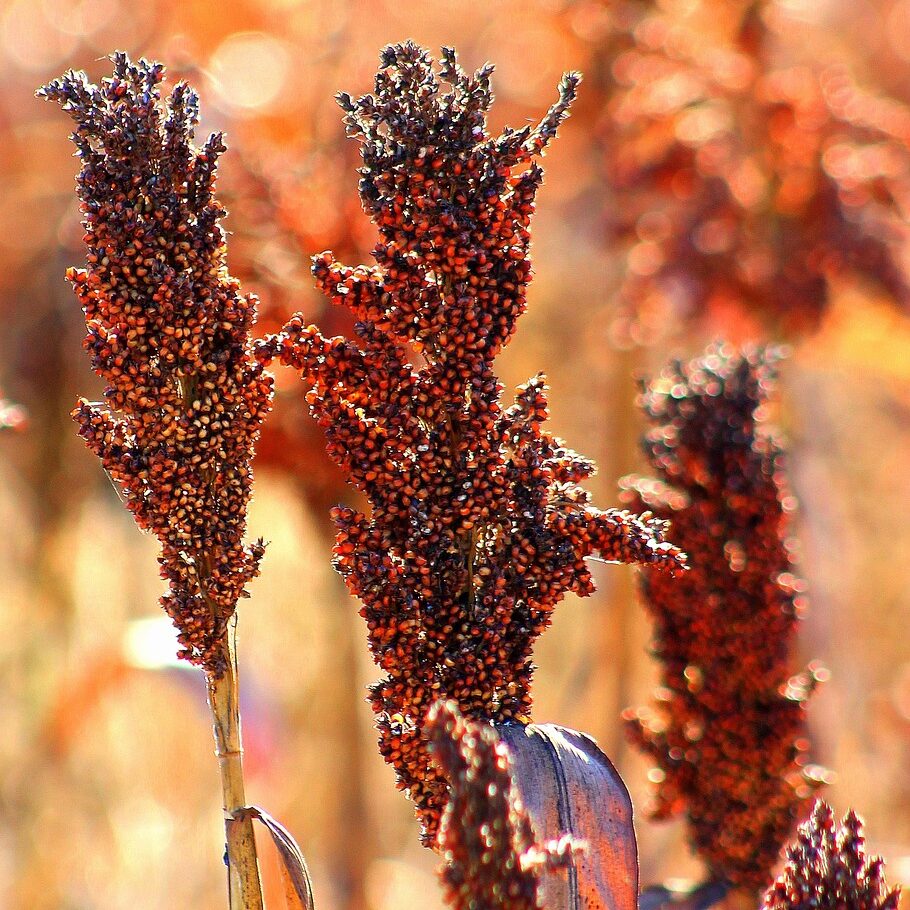
Superfoods- how safe are they for consumption?
While superfoods are generally considered safe for consumption, it’s important to be aware of potential side effects.
Sea Buckthorn – Sea buckthorn is generally safe for most people when consumed in normal food amounts. However, some people may experience mild side effects such as upset stomach, diarrhea, or skin irritation.
Moringa – Moringa is generally safe for most people when consumed in normal food amounts. However, consuming large amounts of moringa supplements may cause nausea, diarrhea, and other digestive issues.
Kelp – While kelp is generally safe for most people when consumed in normal food amounts, excessive intake of iodine from kelp supplements can cause thyroid dysfunction.
Amaranth – Amaranth is generally safe for most people when consumed in normal food amounts. However, people with allergies to wheat and other grains should be cautious as amaranth is often processed in facilities that also process these allergens.
Camu Camu – Camu camu is generally safe for most people when consumed in normal food amounts. However, excessive consumption may cause gastrointestinal issues such as diarrhea and stomach pain.
Celeriac – Celeriac is generally safe for most people when consumed in normal food amounts. However, some people may be allergic to celeriac and experience allergic reactions such as hives, itching, or difficulty breathing.
Jicama – Jicama is generally safe for most people when consumed in normal food amounts. However, some people may experience digestive issues such as bloating or gas.
Black Garlic – Black garlic is generally safe for most people when consumed in normal food amounts. However, people taking blood thinners should be cautious as black garlic may increase the risk of bleeding.
Sorghum – Sorghum is generally safe for most people when consumed in normal food amounts. However, people with celiac disease or gluten intolerance should avoid sorghum as it may contain traces of gluten.
It’s important to remember that while superfoods can be beneficial for health, it’s always best to consume them in moderation and consult with a healthcare professional before incorporating them into your diet.





